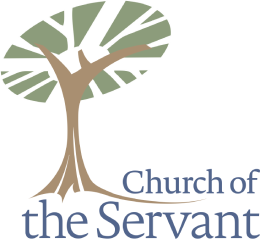Attentive worshipers will have noticed that we have been using a variety of musical settings of the Lord’s Prayer throughout this season. What better way to highlight our focus on the Sermon on the Mount than to sing Christ’s own words from his great sermon using a myriad of musical settings that have been composed through the ages? In some cases, these musical settings of the Lord’s Prayer will be sung on your behalf by one of COS’s musical leaders. I know this can cause a good deal of consternation among some people. Having won this battle during the Reformation, why would we want to give the liturgy back to the clergy at this late date?
Don’t worry, my friends! The congregation will always be the primary choir at Church of the Servant. On the other hand, I think there is something valuable to be gained by exploring different modes of worship. Here are a few thoughts about the balance between singing and listening.
First of all, let me state that I’m very aware of the dangers of worship turning into performance. Whether it’s a choir, praise band, or preacher who is up front, it is far too comfortable for us to fall into the performer/audience relationship that comes so easily to us culturally. COS has done well to resist this model. My personal rule of thumb is that the farther I move away from congregational singing, the more clearly I need to justify the decision. For example, I utilize leader/people responsorial Psalmody because it allows us to sing the Psalms more fully and distributes the gifts of the people in an appropriate way.
For songs sung entirely by the leadership my decisions are even more intentional. In this case, a few specific points informed my decision to shift the congregation from singing to listening mode. First, it is short term. There will only be a few times this season in which the congregation doesn’t sing or say the Lord’s Prayer. So there is no shift in our basic worship theology, but a momentary shift in our typical worship practice. Second, I expect it will break our routine in a positive way. While liturgy is a good method of shaping our worship, the danger is that it is easy for us to go on auto-pilot. This new mode of interaction will force us to re-engage with the words we say each week. Finally, I believe it will be illuminating. Music—especially music from sources as varied as Egypt, Colonial America, Luther’s Germany and Jamaica—has a way of helping us to hear words with new ears. When the congregation returns to speaking the Lord’s Prayer as we usually do, our praying will be reinvigorated for our time away.
Part of the balance is that this kind of liturgical innovation is dependent on a good foundation of worship theology and practice. That is, a sung Lord’s Prayer can help people prayer more deeply, but if they don’t understand that it’s a prayer at all, they’ll just hear it as a choir anthem. The robust worship rhythms we enjoy at COS allow us opportunity for periodic improvisation. Also fundamental to the equation is the congregation’s relationship. The people in the pews need to trust that the leaders are indeed singing or praying on their behalf, and the leaders need to sing, pray, preach, and dance in a way that places the focus on the worship act rather than themselves.
May God bless our both our singing and our listening.
Can’t tell a responsorial Psalm from a responsible sum? Contact Greg Scheer (greg.scheer@coscrc.org).
